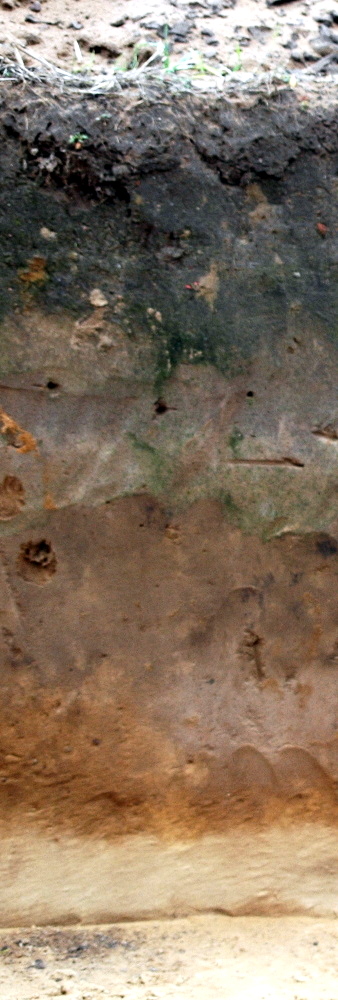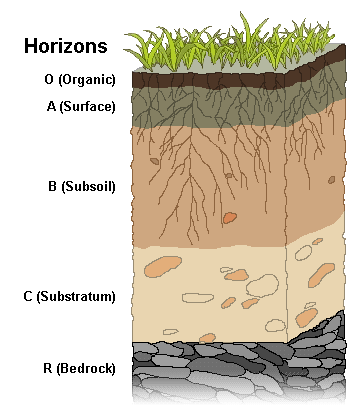 From Soil to Fruit
From Soil to Fruit- Appendix 2: Soil Science
- Pedology
- Soil Horizons
Soil Horizons
A soil horizon is a band, or layer, parallel to the surface and positioned vertically within the soil. Each horizon is distinguishable from the horizons above and below, and differs by colour, composition and texture.
Horizons are only visible in undisturbed soils in their natural state (Fig. 1). Cultivation or other mechanical churning of soil disrupts these natural layers.

Attribution: Radosław Drożdżewski (Zwiadowca21) / CC BY-SA (https://creativecommons.org/licenses/by-sa/3.0)
Different soil types can have different soil horizons, and some horizons may be missing altogether, but the ones most soils have in common are represented in Fig. 2 below:

Attribution: Wilsonbiggs [CC BY-SA 4.0 (https://creativecommons.org/licenses/by-sa/4.0)]
The O (organic) horizon is the topmost layer. It comprises organic matter at different stages of decomposition from leaf fragments to highly decomposed humus. Its depth can range from non-existent in deserts to 50 mm or more in rainforests.
The A horizon is the surface soil. ‘Topsoil’ is another word for this layer which may be no more than 100-200 mm thick. This is the most fertile horizon as it contains the highest amount of organic matter and microbial and animal life. It is usually the darkest horizon because of that organic matter, and plant roots are numerous here.
The B horizon is the subsoil, and could range from tens of centimetres to several metres thick. It isn’t as fertile or as rich in soil life as the A horizon but it is still recognisable as soil with a structure, though different to that of the A horizon above it. Plant roots extend well into the subsoil. The B horizon has much less organic matter and is typically lighter in colour than the A horizon as a result. Its colour is often red to brown owing to the iron oxides present. This horizon is actually where iron oxides and other minerals accumulate if transported from the surface by water, and this tendency to concentrate in the B horizon defines the colour enough that this layer is readily distinguishable from the others.
The C horizon is the substratum, comprised mostly of fragmented bedrock with clay minerals. Very little soil formation, or pedogenesis, occurs here. It can range from quite shallow to quite deep within the soil profile.
The R horizon is the hard bedrock — it would be called an outcrop if it were exposed. While the C horizon contains fragmented bedrock that can be removed by hand (perhaps with effort), the bedrock in the R horizon is a continuous solid mass that would require a lot of mechanical force to break up and remove.
About the Author
BSc(Hons), U.Syd. - double major in biochemistry and microbiology, with honours in microbiology
PhD, U.Syd - soil microbiology
Stumbled into IT and publishing of all things.
Discovered jujube trees and realised that perhaps I should have been an agronomist...
So I combined all the above passions and interests into this website and its blog and manuals, on which I write about botany, soil chemistry, soil microbiology and biochemistry - and yes, jujubes too!
Please help me buy a plant if you found this article interesting or useful!